Our top 6 tips for selling internationally on Shopify
- Jo Silverwood
- Read time: 22 minutes

In today’s competitive global commerce marketplace, more and more brands are starting to sell internationally. Shopify’s capability to accelerate international expansion means potentially lucrative new markets are within reach, facilitating the futureproofing of businesses.
With global eCommerce sales forecasted to reach $6.3 trillion in 2024 according to a report by eMarketer, there is no doubt that selling internationally provides a huge opportunity for merchants worldwide.
It makes perfect sense to choose Shopify when expanding into new markets. Shopify is continually investing in new functionality and making improvements to cross-border selling tools like Shopify Markets, making life easier for merchants to sell across the globe. Navigating the challenges of selling into new markets can be difficult – there’s a lot to consider, from different currencies and payment methods, content localisation, pricing strategies, domains, duties, shipping and legal compliance.
In recent years, Shopify has realised the need to make selling internationally as easy as selling domestically for merchants. With the release of Shopify Markets, Shopify Markets Pro, and even its own native translation app Translate & Adapt, Shopify is certainly helping merchants overcome previous barriers to export and opening doors to new revenue opportunities.
Here are Herd’s top 6 tips on how to launch successfully into new markets and sell internationally with Shopify.
- Identify the right international target market
- International domains and SEO
- Multi-language stores
- Multi-currency and payment methods
- International shipping
- International duties and taxes
1. Identify the right international target market
The first step on your journey to global success with international expansion is to research which market/s offer the best opportunity for your business to thrive. But where to start? You may have already received some international orders organically without targeting any specific overseas market- this could offer a good starting point in your market research into where to begin your localisation efforts.
Try analysing current traffic and sales-by-country data in your analytics dashboard. Shopify offers robust reporting and allows merchants to show sessions by country, customers by country, and sales by billing country.

Google Analytics engagement demographics reports can also offer in-depth information about the location of your visitors by continent, country, region, or city. This can help you determine potential markets you wish to target based on previous visitors and sales to date, which may reveal there is already a demand for your product or service in their locale.
It's vital to do some detailed research into your target market before you spend any time or money on setting up a new store. This could include multilingual keyword research, competitor analysis, or researching market trends to scope out whether the potential market size aligns to your business’ aspirations for that market. When it comes to international expansion, the last thing you want to do is invest upfront before you’ve validated that your products or service will resonate with local consumers.
Find out more about how to create a robust international marketing strategy before you start setting up your new international store.
2. International domains and SEO
More than half of online users use a search engine to inspire and discover products when shopping, according to Statista, with Google taking the lion’s share - almost 92% worldwide across all devices. When trying to sell internationally, it makes perfect sense to make sure your store is going to rank well on google in the target country. This is why a robust international domain strategy and best practice international SEO tactics are a vital aspect of your international marketing. Such planning will allow you to attract international customers and increase your store’s conversion rates in new markets.
The first step to success is to set up the right international domain structure.
International domains allow you to create a more localised store and improve user experience – a personalised local version of your store boosts the confidence of your target market. When international domains are implemented correctly, search engines will direct users to the appropriate version of your store, and if the store is configured in the customer’s local language and currency, they are more likely to buy from you. Find out more about considerations and setting up international domains on Shopify
One useful way to set up an international domain to test out a new market without a significant financial or human resource commitment is with Shopify Markets. On the Herd site, we’ve implemented two international domains with Markets, which uses subfolders to target the USA and Spain:
Herd.io/es-es – targeting Spain in the Spanish language
Herd.io/en-us – targeting the USA in the English language
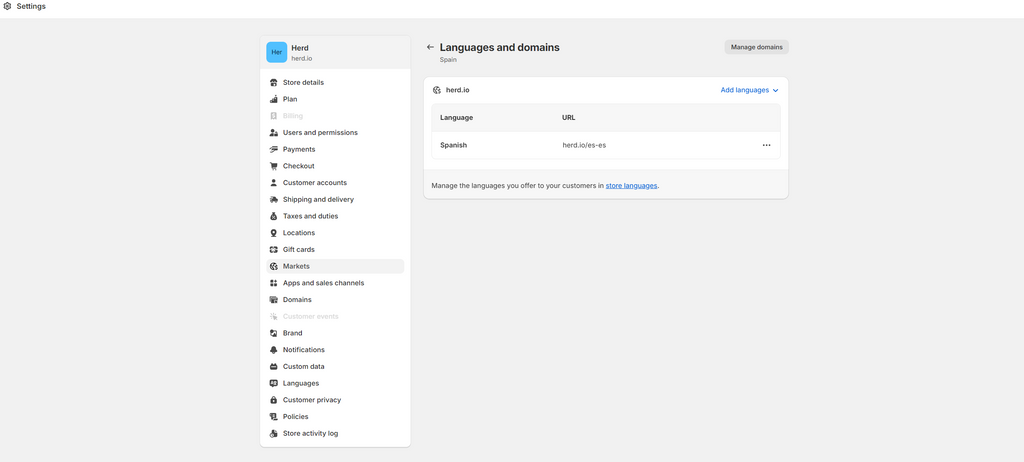
Shopify Markets also allows you to choose subdomains (us.mystorename.com) or a country specific domain (mystorename.us). Shopify Markets will set up the correct international SEO tags and automatic storefront redirection to ensure the right store appears in SERPs depending on the browser’s location. This feature will automatically redirect visitors to the market-specific domain or subfolder for their region, ensuring international customers always see the localised version of your store, while optimising organic search visibility in each international search engine you want to appear in.
Go one step further and implement a best practice territory and language switcher to give customers the option to select their country and preferred language from the main navigation. Providing dedicated switchers can be the difference between losing and gaining a new international customer. For example, Spanish and US users can easily switch territory and language on our store at any time.
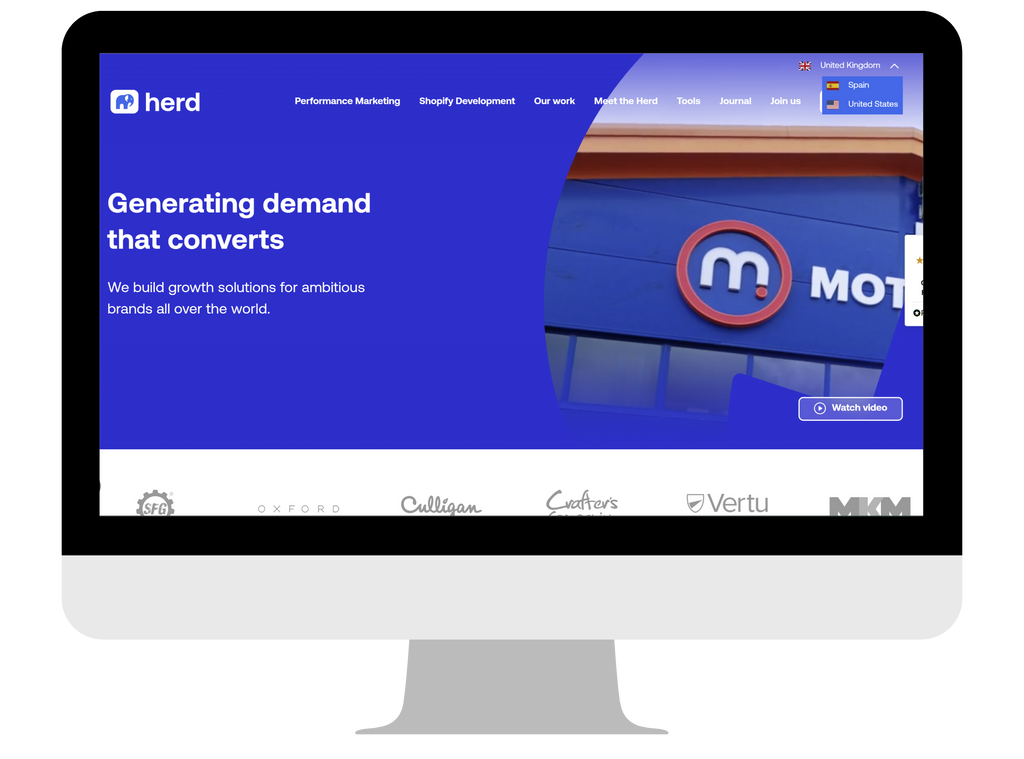
There’s a lot more to international SEO best practice than correct URL structure and store implementation. Once you’ve got your technical foundations in place, the next step is to conduct in-depth keyword research for each market you want to sell to. Even if you only rollout to countries who speak the same language, customers may search for your product using different search terminology. For languages you don’t speak, always instruct an expert, who not only speaks the language but understands SEO, to conduct multilingual keyword research for you in the target country language. This ensures you are using the right keywords on your new store to optimise your organic visibility in global search engines.
Discover our top international SEO tips to maximise global sales and download our handy 18-step comprehensive guide to make sure you’ve got everything covered for your international SEO strategy.
If you have more complex business requirements, you may need to set up individual stores for different countries or regions. Regional inventory needs may mean you require full flexibility and customisation capability for each region or country. In this case, Shopify Expansion stores are the right choice for you. These are completely new stores for your brand, which can operate autonomously in different regions. Merchants on the Shopify Plus plan can add up to nine expansion stores at no additional set up cost, straight from the admin panel. Our article explains everything you need to know about Expansion stores, and you can also discover more about the differences, similarities, features and benefits of both Shopify options in our article ‘Shopify Markets vs. Shopify Expansion stores’
3. Multi-language stores
76% of consumers feel more confident purchasing from stores which feel familiar, according to CSA, so it’s no surprise that stores displaying localised key product information, local currency, and familiar payment methods can expect more international sales than those that don’t meet the needs of the local market.
Shopify supports 20 languages and over 130 currencies, allowing merchants to localise their store and unlock potential for customers all over the world to make purchases in their native language. Whether you are shopping from the UK, EU, China, Latin America, or Australasia, Shopify stores will show the appropriate language, leading to more sales and better conversion rates because customers can understand key information such as product details, shipping, and return policies. Offering a personalised UX is the key to customer satisfaction and success in terms of selling internationally – think global but act local is our recommendation here.
There are three main approaches you can take when considering website localisation for your Shopify store:
-
Fully comprehensive human translation. This involves having a professional, native speaking translator manually localise all aspects of your store - from transactional pages between homepage to checkout, to all other sections like blogs, terms and conditions, and other legal documents. This is a big financial investment upfront, but certainly the best way to ensure linguistic and cultural accuracy.
-
Machine-only translation using a third party app. This involves choosing from one of over 50 Shopify compatible translation apps, and relying on this to automatically translate your store. While this is a useful and low-cost starting point, machines are never 100% accurate when it comes to localisation- they can’t often convey the right meaning in the target language, especially when it comes to creative content such as campaign slogans, taglines, even brand names. Reliance on an app alone could lead to embarrassing mistakes on your website which could alienate potential customers, or worse, result in a breach of local law or legislation. This is one reason why we would never recommend this as a stand-alone approach for localisation of any website. Find out more in our article on Human vs machine translation.
-
Hybrid approach to store localisation - a more budget friendly option for any company wishing to test out new markets before investing heavily in full localisation of every page of your store. This approach uses a blend of human and machine assisted translation. You would use machine translation to fully localise the store, then use professional translators to proof and edit the most important store content in priority order, such as top performing product pages (and all legal content).
Our approach to the hybrid option includes our Shopify international experts recommending the right translation app for your business from the 50 on offer on the Shopify app store, to run the whole store translation initially. Our professional linguists would then proof the machine translations on the agreed list of top performing URLS (often called post editing), to correct any mistakes and ensure 100% linguistic accuracy and also that the content reads naturally to a native speaker before going live in the new market.
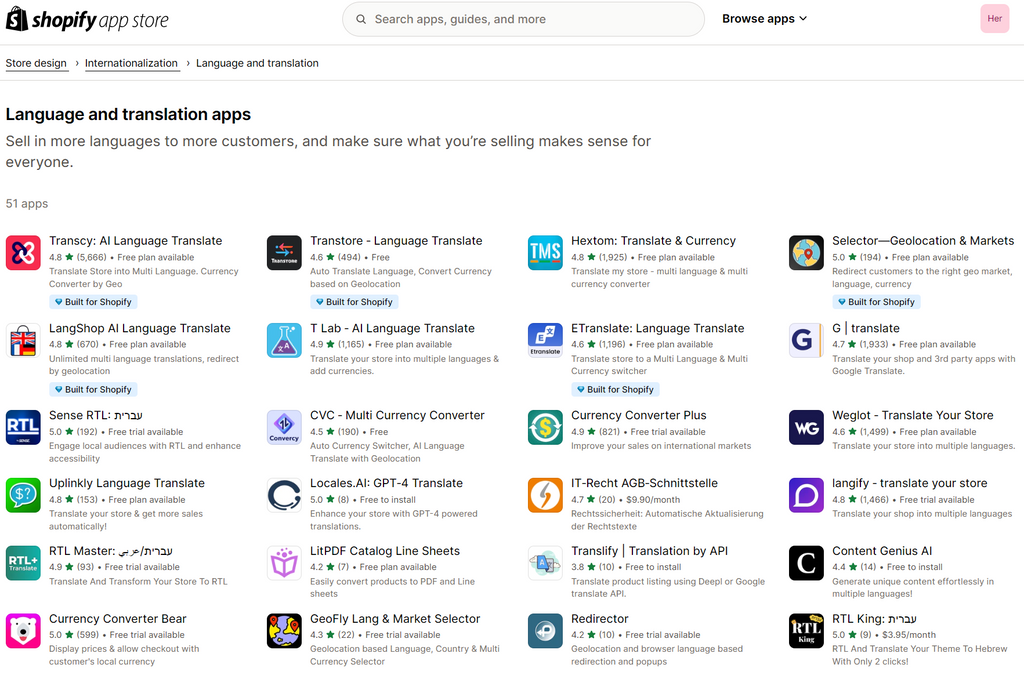
Image: Shopify app store
We also ensure cultural relevancy for the local market, making any recommendations about adaptations required to content based on knowledge about the culture, and multilingual keyword research (if this has taken place at the market research stage). Multilingual keyword research is important because your keywords may differ in another language depending on the way foreign users search for similar products. There’s far more to this than simply translating keywords from one language to another –this level of linguistic and cultural localisation is one thing the machines can never do!
Then when you’ve started to see some return on investment in the new market, we can continue localising more content later such as blog articles or other less important collections and product pages if they haven’t already been localised for the initial launch.
Herd offer several tailored hybrid options to suit all businesses and budgets when it comes to localising Shopify stores. We help merchants launch into new markets successfully, in a way that’s right for their business.
4. Multi-currency and payment methods
One of the biggest barriers to conversion in international markets is not offering local payment methods or currencies. According to Shopify research, 92% of shoppers prefer to make purchases from stores offering their local currency, while almost half of shoppers in the US and UK are likely to abandon basket if their local payment option is not offered at checkout.
Customers want to see prices they can understand at a glance without having to convert them into their own currency – think about creating that seamless user experience and make it easy for the customer to buy from you, and you’re more likely to get that conversion. If they can pay in their own currency using a familiar payment method, this can increase conversion rates by up to a whopping 40%, so localising your currency and payment options really is a key driver to success in international markets. Read more about multi-currency ecommerce benefits and how to implement it on Shopify.
There are many apps in the Shopify app store which can help you to convert currencies at checkout and automatically round-up prices to match your pricing strategy in other markets.
The good news is that Shopify Markets built-in functionality includes currency conversion based on exchange rates, allowing merchants to auto convert, set percentage adjustments for each market, and display prices in local currencies when using Shopify payments.
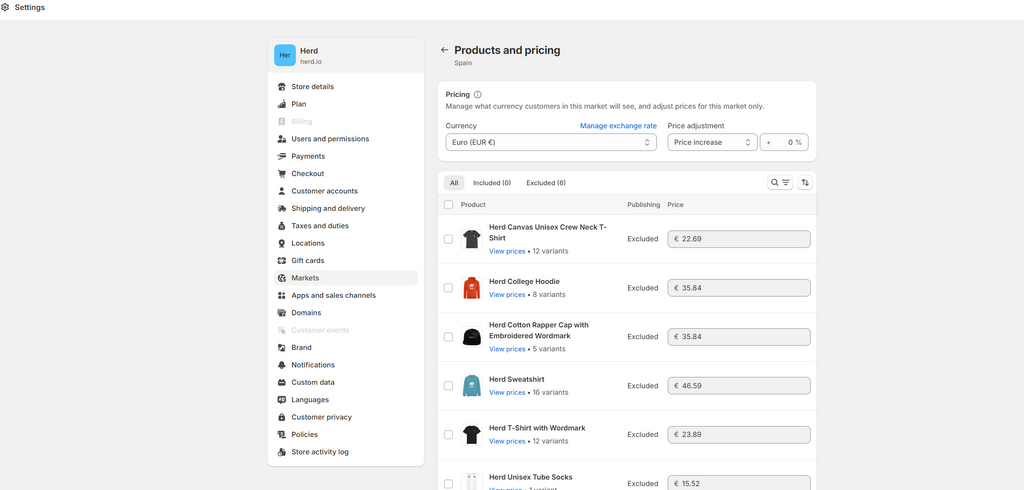
Shopify Payments allow multi-currency payments in 133 local currencies, and local payment methods such as Klarna, Sofort, iDEAL, and Bancontact, enabling you to improve your performance internationally. By offering multi-currency payment methods you can experiment with your growth strategy in international markets, adding or removing currencies on a country-by-country basis as international markets change. You can also launch in new markets and select only the currencies you would like to sell in. Find out more about setting up Shopify Payments.
In addition to allowing customers to checkout in their preferred currency and payment method, you can also improve your international checkout experience by automatically localising address forms, which is built into Shopify with Google autocomplete.
Shopify also facilitates estimated import duties and taxes at the checkout, giving customers full clarity on the final price they will need to pay to receive their order, and let shipping carriers remit these charges.
If you are US based, Shopify Markets Pro is an upgrade from the standard Shopify Markets functionality. It offers the ability to further expand some of the complex cross-border selling challenges from operations to enhanced localisation features and automation.

Image: Shopify
5. International shipping
When it comes to international shipping, there are a host of factors to consider to ensure a seamless delivery experience, leading to happy and loyal customers. These include calculating accurate international shipping rates, labelling regulations and packing slips, duties and tax calculation, inventory management, tracking emails and notifications, and choosing the right courier for the destination.
After setting up the markets you want to sell to, the next step is to set up shipping zones in Shopify to send products worldwide. You can create zones for markets you want to ship to based on international shipping rates for that group of countries or region. For example, you could set up a market containing all EU countries with one shipping zone and charge one flat rate for European customers.
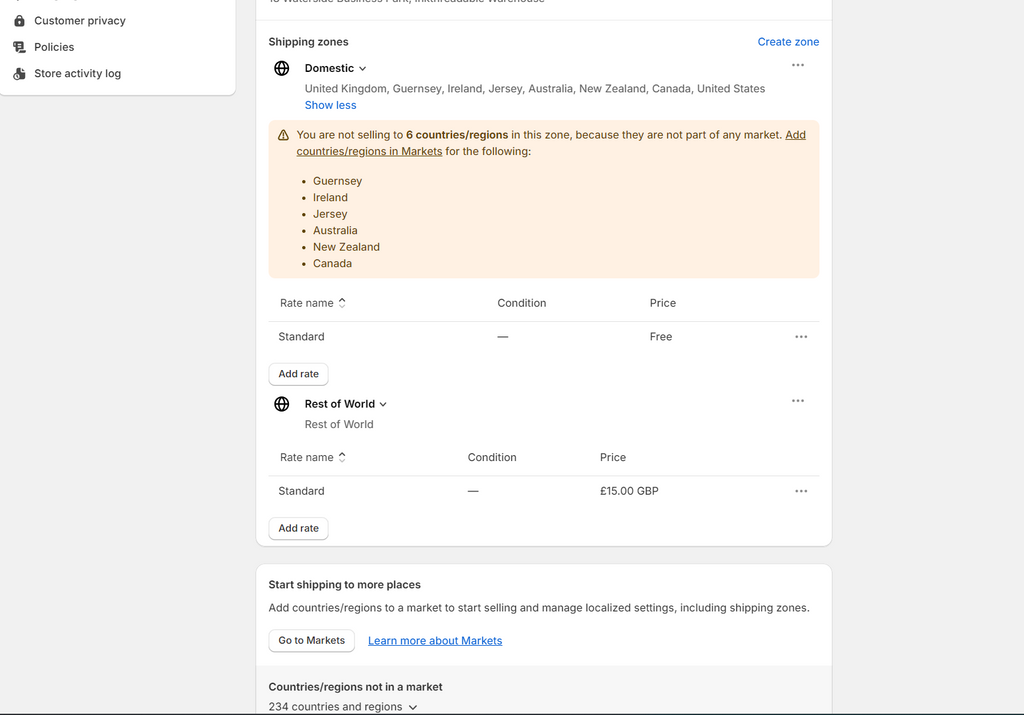
Merchants also need to factor in size and weight, which can determine the shipping costs depending on destination. Be aware that packages that are shipped internationally are charged based on what’s larger; actual weight or volumetric weight (how much space the package occupies). Find out more about packages and shipment weights.
You can save time, money, and potential issues caused by human error by integrating a suitable international shipping app to help automate your Shopify store’s international order fulfilment and optimise your shipping operations. These apps offer features such as real-time shipping rates to customers, label generation, and carrier selection to help enhance the overall experience. Most apps for Shopify work with multiple carriers like UPS, USPS, FedEx, and DHL allowing you to choose the best carrier for each individual order based on factors like speed, cost, and destination.
There are many Shopify apps that can help with international shipping. Some are free and others operate on a subscription basis or charge per order. It’s important to choose the right one based on your business size and requirements, and test it out to ensure it integrates smoothly with existing processes. Getting this right will allow you to expand your customer base and make international markets more accessible.
Finally, creating a clear international shipping and returns policy, including prices and lead times per country or region is key to ensure international customers know how much they will pay and when they can expect their order to arrive. Shopify have clear shipping policy guidance templates, where to display this information on your storefront, and case study examples on how to localise this for different markets.
Having a good and transparent international shipping policy is paramount to build and maintain customer trust and will communicate all information required to ensure happy customers, as well as protect your business should a complaint about cost or delivery times occur. It can also save time in answering repetitive questions from international buyers about when their order might arrive, as you will have this covered in your policy in detail. It can also be helpful to include an FAQ section on your site to cover all of these (and other) questions international and domestic buyers may have about ordering from your store.
If you are a Shopify Plus merchant, you can learn more in Shopify’s online course about developing the right shipping strategy for your business.
6. International duties and taxes
An important aspect of your international commerce strategy includes being clear and transparent about any additional sales tax, import tax, and duties that may apply to any international order. If buyers experience unexpected additional costs when their order lands, it could lead to a dissatisfied customer and ultimately parcel refusals, returns, and chargebacks.
Firstly, consider how to charge and display sales taxes to your buyers in each market. For example in North America, it is most common to show prices excluding taxes, and add them at the checkout. In Europe or Asia Pacific, buyers expect prices shown to be all-inclusive of taxes. When you have a tax obligation for any other country you ship to, either include or exclude those in your product prices.
If you upload specific prices per country, upload them including the taxes exactly as you would want them to appear on the storefront.
If using price adjustments, we recommend using the ‘Include or exclude tax based on your customer's country’ tax setting to auto include/exclude the tax on the storefront price shown based on your buyer’s country.

For example, if you are based in the USA but sell to the UK, you will want prices to include VAT. When you activate the setting, prices will automatically add the VAT, ensuring no nasty surprises at the checkout. For a UK store selling into the USA however, you would want to exclude the sales taxes as buyers expect to see these added on at the checkout.
Dealing with international import taxes and duties can be complicated. Depending on your target markets, you might need to register for VAT, GST, or other taxes. Shopify can handle most common tax calculations automatically, but consulting with a tax professional is important to ensure compliance with all local tax laws. Some Shopify apps, like Avalara AvaTax, can also assist with tax compliance for merchants on the Plus plan only.
Finally, if you are a UK company selling into the EU, you’ll need to be aware of the Post Brexit EU VAT rules, what this means for Shopify merchants, and what action to take to ensure compliancy. Our post Brexit UK-EU exporting guide also explains two further important elements that need consideration when forming an international shipping strategy; setting up HS codes, and for Shopify Advanced or Plus merchants, setting up DDP delivery with duties and taxes paid. This helps with frictionless cross-border selling, offering a transparent total landed cost for international buyers.
Key takeaways
By implementing our 6 tip checklist, Shopify merchants will be able to optimise stores for global markets and secure organic visibility in many different countries. Remember to:
- Do your research before spending time and money. Ensure you are targeting the right international market for your business
- Implement an international URL structure and expansion strategy that suits your business needs with either Shopify Markets or Expansion stores
- Localise all transactional aspects of your store, from currencies to payment methods
- Implement a robust international SEO strategy, from keyword research to content localisation
- Never EVER rely solely on machines to localise your stores language content and always have translations checked by an expert
If you have any questions, or need help with your international expansion and optimisation of existing international stores, don’t hesitate to get in touch with our team of Shopify experts.